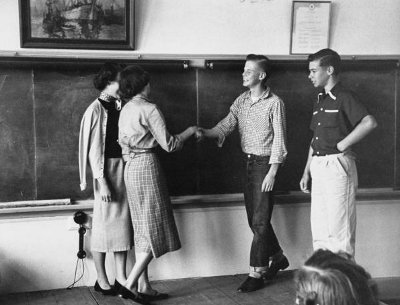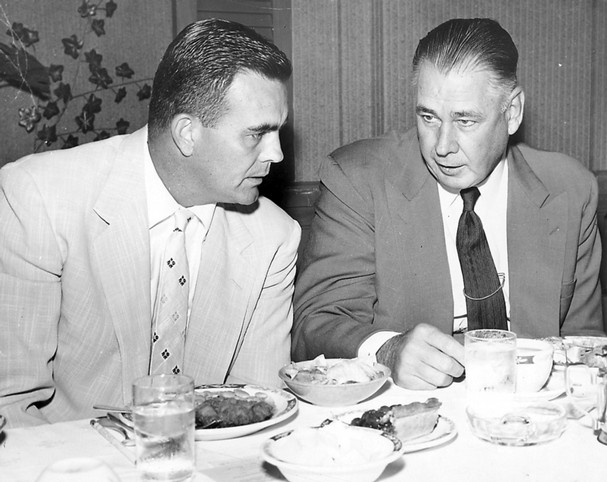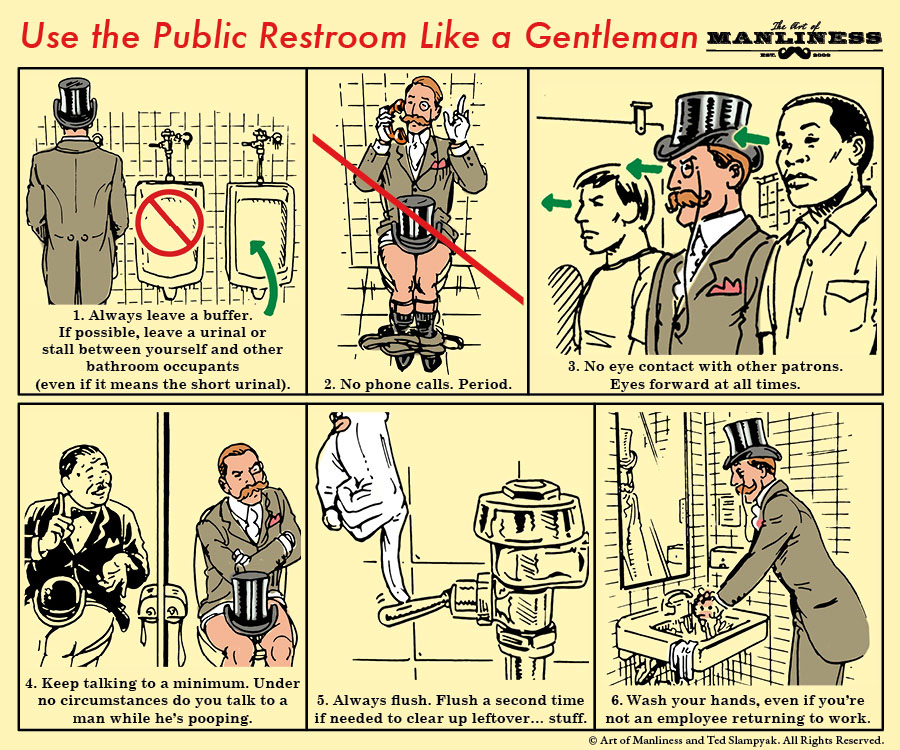
Have you ever been at a party with a guy who runs into somebody he knows and starts yammering away while you stand there awkwardly, holding your drink? Man, I hate when that happens. You’re left in social limbo. I usually have to just take things into my own hands and introduce myself, which is fine, but the exchange would have been much smoother had my friend introduced me to his buddies.
Being introduced invites you into the conversation and makes you feel like part of the group, which is why making an introduction shows your respect for your guest. Neglecting to make an introduction leaves a person feeling ignored and, well, awkward. Making introductions is particularly important in business settings as they establish a rapport of respect, get relationships off on the right foot, and give you an aura of being confident, prepared, and in control.
With our more casual culture, the art of the gentlemanly introduction has disappeared, but we’re here to help bring it back.
Making introductions used to be a much more formal affair, with bowing, scraping, and a lot of rules, but nowadays just remembering to make them sets you apart from the cads out there. So there’s no need to adhere to ironclad laws or be all flowery about it. Keeping it simple and respectful goes a long way, and doing so requires following just one basic guideline:
The Big Rule
The overarching principle when making introductions is deference and respect. You show chivalrous deference to women by introducing the man to the woman. You show respect for your elders by introducing the younger to the older. And in a business setting, you show respect to higher-ups by introducing the person of lower rank to the person of higher position. Below we break down this rule into a few easy to understand examples so you can see how this works.
Business Introductions
Situation: Introducing business associates of different ranks
- How to do it: Introduce the person of lower rank to the person of higher rank, regardless of age or gender.
- Example: “Mr. CEO, I would like to introduce Mr. Frank Underling from accounting.”
Situation: Introducing a business associate of any rank and a client
- How to do it: Introduce the business associate to the client, regardless of rank, age, or gender.
- Example: “Mr. Client, please meet our Vice President of Marketing, Andrew Smith.”
Situation: Introducing two business associates of equal rank
- How to do it: Introduce the person that you don’t know as well to the person you know better.
- Example: Let’s say your manager, Foster Knight is meeting the manager of the Detroit office, Cynthia Brown. “Foster, I’d like you to meet the manager of the Detroit Office, Cynthia Brown.”
Social Introductions
Situation: Introducing a man and a woman
- How to do it: Introduce the man to the woman
- Example: “Amanda, this is Jake Nelson who has been helping me study for the bar.”
(Note: In social settings, a man is always introduced to a woman, regardless of the individuals’ ages.)
Situation: Introducing a younger person and an older person (of the same sex)
- How to do it: Introduce the younger person to the older person.
- Example: “Mr. Mothballs, I’d like you to meet my friend Roy. He’s my roommate in college.”
Situation: Introducing a person and a relative
- How to do it: Introduce the person to the relative.
- Example: “Dad, I would like to introduce my girlfriend Carly.”
Situation: Introducing one or more persons and a group of people
- How to do it: Introduce the group to the individual(s).
- Example: “Sarah and Andy, I would like you to meet Mike, Bruce, Jim, and Harvey.”
Notes on group introductions:
- Say the names of everyone in the group slowly so that your guest will have a greater chance of remembering them.
- If your bring your guest to a small gathering, you may introduce him or her to everyone there. If you bring your guest to a large party, just introduce them to whom they’re sitting by or those people who enter into a conversation with the two of you. Don’t bring them around the room and introduce them to every single person there.
What to Do When Being Introduced
Remember that first impressions are always the time to shine, so when being introduced to someone, look them in the eye, offer a good handshake (when meeting a woman, wait to see if she extends her hand first), and say something like:
- “I’ve really been looking forward to meeting you.”
- “I’ve heard such great things about you.”
- “It’s a pleasure to meet you.”
- “It’s great to finally meet you.”
Then, immediately follow-up with a conversation starter. “Rodger told me you’ve been training for a marathon next week. How’s that going?”
Other Tips
- Rely on common sense when choosing whether or not to use a person’s title when making an introduction. In formal situations and when the person has not given you permission to use their first name, use titles like Mr., Mrs., Dr., etc. A good rule is simply to refer to the person as you normally refer to them. If you’re introducing your boss and you call your boss “Mr. Cooper” at the office, don’t suddenly call him Bob.
- Always stand up for introductions.
- Make sure you know how to pronounce people’s names correctly when making introductions.
- Say something interesting about the person you’re introducing so that the person he or she is being introduced to will have an easier time remembering their name and transitioning into conversation. Like so:
- Sam: “James, I’d like to introduce you to my friend Eddie Hill. Eddie caught a 20 lb bass last week.”
- James: “That’s incredible! Where were you fishing, Eddie?”
Boom. Instant rapport.
- When being introduced or making an introduction outside, remove your hat and keep it off until you part ways again.
- If outside and wearing gloves when meeting someone, remove your glove before shaking his or her hand.
- What do you do when you’re introducing your guest to another person and realize you don’t remember their name? Say to the person, “Have you met my friend John?” The person will then hopefully reply with, “No, I haven’t. I’m Sophia.”
Listen to our podcast with John Corcoran for more on networking:







